It looks like you're using an Ad Blocker.
Please white-list or disable AboveTopSecret.com in your ad-blocking tool.
Thank you.
Some features of ATS will be disabled while you continue to use an ad-blocker.
10
share:
It wasn’t exclusively the arrival of new people from Africa with new technology that changed the stone tool repertoire of early humans in Eurasia a few hundred thousand years ago—it was local populations in different places and times gradually and independently wising up to a better industry on their own.
Local evolution of stone tools
Researchers examined thousands of stone artifacts recovered from Nor Geghi 1, an Armenian Southern Caucasus archaeological site that features preserved lava flows and artifact-bearing sediments dated to between 200,000 and 400,000 years ago. The artifacts, dated at 325,000 – 335,000 years old, were a mix of two distinct stone tool technology traditions—bifacial tools, such as hand axes, which were common among early human populations during the Lower Paleolithic, and Levallois, a stone tool production method typically attributed to the Middle Stone Age in Africa and the Middle Paleolithic in Eurasia.
Based on comparisons of archaeological data from sites in Africa, the Middle East, and Europe, the study authors suggest that this change was gradual and intermittent, and that it occurred independently within different human populations who shared a common technological ancestry. In other words Levallois technology evolved out of pre-existing biface technology in different places at different times.
Ok help me out here I was under the impression that "Modern US" came out of Africa at about 100,000 yrs ago give or take,so who are the folks
being talked about at 325,000 – 335,000 ago, are they " US" or our more distant cousins,like Neanderthal and others.
a reply to: Spider879
Yes.
The latter, not the former.
humanorigins.si.edu...
are they " US" or our more distant cousins,like Neanderthal and others.
Yes.
The latter, not the former.
humanorigins.si.edu...
edit on 9/27/2014 by Phage because: (no reason given)
I thought I'd add some photos from Hans'
original source.
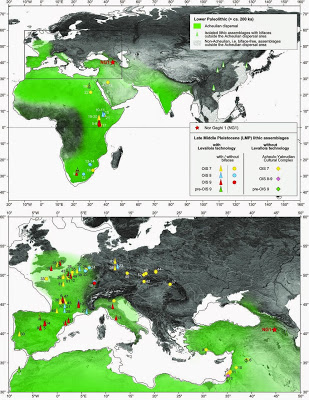
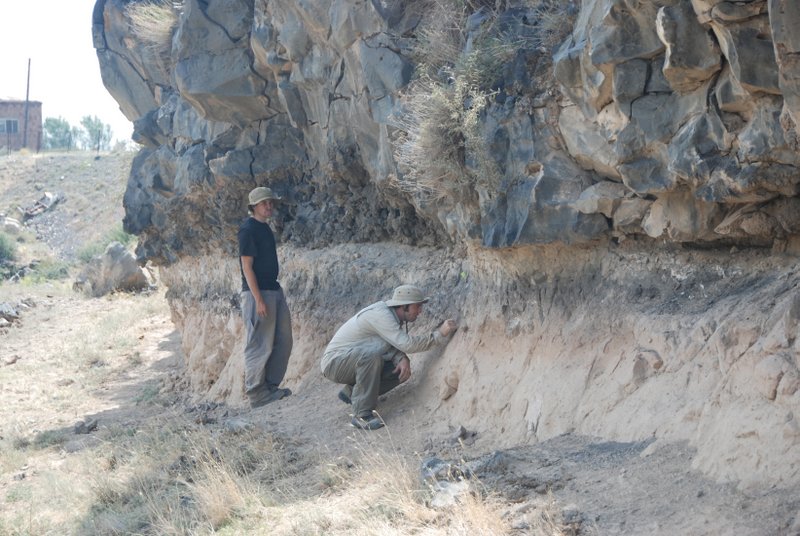
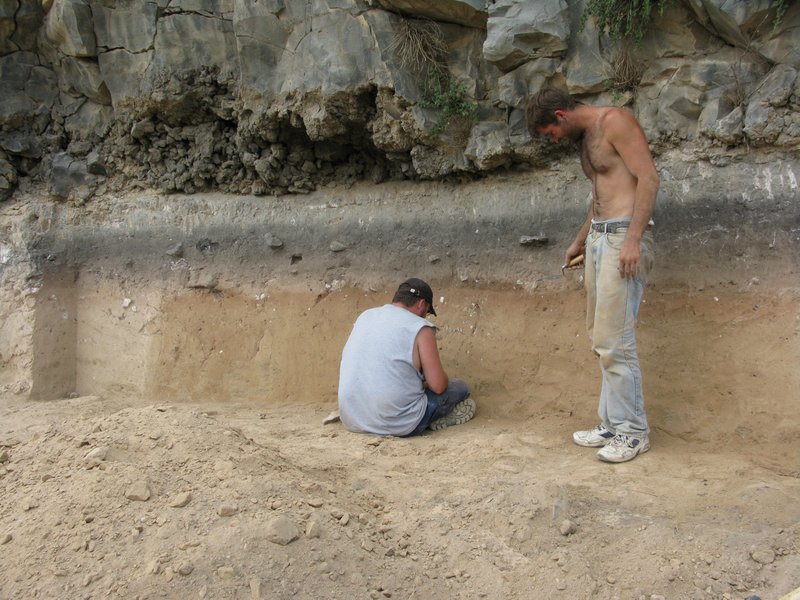
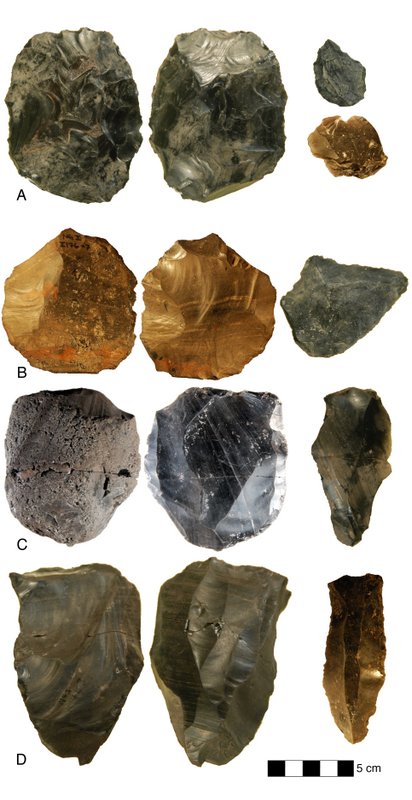
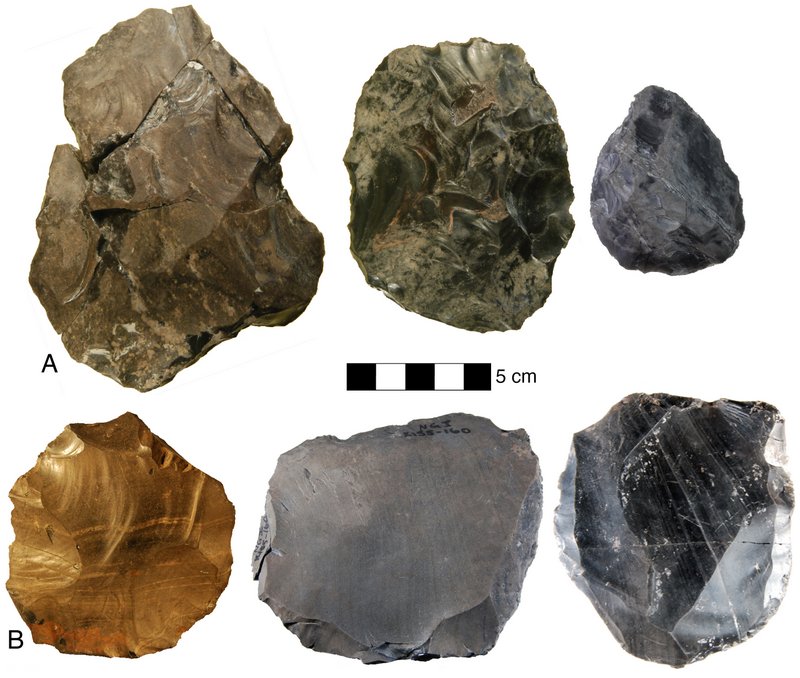
popular-archaeology.com...
original source.


The discovery of Nor Geghi 1 (NG1), July 2008, with Basalt 1 (top) and stratigraphic Units 1–5. N. Researchers Wales and P. Glauberman are pictured. Credit: Daniel S. Adler

Representative stratigraphic section of Nor Geghi 1 (NG1), with Basalt 1 (top) and Units 1–5, following the 2009 field season. Credit: Daniel S. Adler

Technological variability at Nor Geghi 1 (NG1). A) Biface with two biface resharpening/thinning flakes. B–C) Levallois cores with Levallois flakes. D) Blade core with blade. A) The biface is the desired product, with the flakes detached during shaping and resharpening treated as waste. B–D) The flakes and blades are the desired products and were used in an unmodified state or retouched into a variety of tool types. Credit: Daniel S. Adler

Technological evolution and variability at Nor Geghi 1 (NG1). A) bifaces, B) Levallois cores. Credit: Daniel S. Adler
popular-archaeology.com...
Hans,
Your OP study further re-enforces this paper from last year that shows two distinct Neanderthal cultures in western Europe.
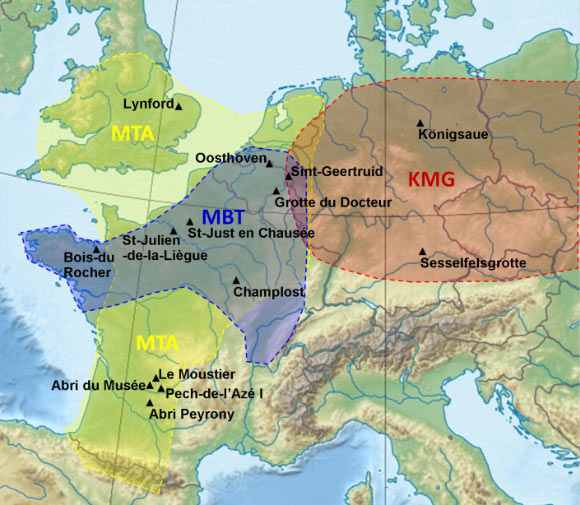
and further more,
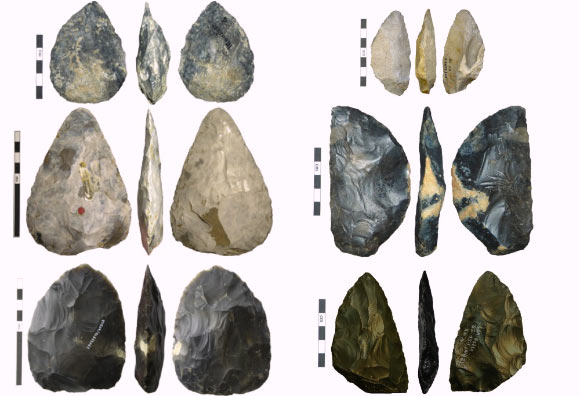
www.sci-news.com...
Your OP study further re-enforces this paper from last year that shows two distinct Neanderthal cultures in western Europe.
Stone Tools Point to Two Distinct Neanderthal Cultures
Aug 20, 2013 by Enrico de Lazaro
« PREVIOUS | NEXT »
A study of 1,300 stone hand axes found at 80 Neanderthal sites in France, Germany, Belgium, Britain and the Netherlands shows that two cultural traditions existed among Neanderthals living in what is now northern Europe between 115,000 to 35,000 years ago.

Location of the study sites and Neanderthal cultures: Mousterian of Acheulean Tradition, MTA, Keilmessergruppen, KMG, and transitional – Mousterian with Bifacial Tools, MBT (Karen Ruebens)
Two separate hand axe traditions or designs existed – the Mousterian of Acheulean Tradition in a region now spanning south-western France and Britain and the Keilmessergruppen Tradition in Germany and further to the East, according to study author Dr Karen Ruebens from the University of Southampton, who reported the results in the Journal of Human Evolution. She also identified an area covering modern day Belgium and the Netherlands that demonstrates a transition between the two.
“In Germany and France there appears to be two separate hand axe traditions, with clear boundaries, indicating completely separate, independent developments,” Dr Ruebens commented.
“The transition zone in Belgium and Northern France indicates contact between the different groups of Neanderthals, which is generally difficult to identify but has been much talked about, especially in relation to later contacts with groups of modern humans.”
“This area can be seen as a melting pot of ideas where mobile groups of Neanderthals, both from the eastern and western tradition, would pass by – influencing each other’s designs and leaving behind a more varied record of bifacial tools.”
and further more,

Neanderthals in the western region made symmetrical, triangular and heart-shaped hand axes, while during the same time period, in the eastern region, they produced asymmetrically shaped bifacial knives.
“Distinct ways of making a hand axe were passed on from generation to generation and for long enough to become visible in the archaeological record. This indicates a strong mechanism of social learning within these two groups and says something about the stability and connectivity of the Neanderthal populations,” Dr Ruebens said.
“Making stone tools was not merely an opportunistic task. A lot of time, effort and tradition were invested and these tools carry a certain amount of socio-cultural information, which does not contribute directly to their function.”
The analysis also reveals other factors which could have influenced hand axe design, such as raw material availability to Neanderthals, the function of their sites, or the repeated reuse and sharpening of tools – didn’t have an impact in this instance.
The study adds a new archaeological perspective on Neanderthal regionality, which is a concept also identified in studies of their skeletal and genetic features.
www.sci-news.com...
edit on 30-9-2014 by punkinworks10 because: (no reason given)
new topics
-
New York Governor signs Climate Law that Fines Fossil Fuel Companies
US Political Madness: 42 minutes ago -
Meta Llama local AI system is scary good
Science & Technology: 5 hours ago -
This is why ALL illegals who live in the US must go
Social Issues and Civil Unrest: 7 hours ago -
UK Borders are NOT Secure!
Social Issues and Civil Unrest: 9 hours ago -
Former ‘GMA Producer’ Sues NPR-Legacy Media Exposed
Propaganda Mill: 11 hours ago -
New Footage - Randy Rhoads 1979 LIVE Guitar Solo Footage at the Whisky - Pro Shot
Music: 11 hours ago -
Happy Hanukkah…
General Chit Chat: 11 hours ago
top topics
-
This is why ALL illegals who live in the US must go
Social Issues and Civil Unrest: 7 hours ago, 16 flags -
Former ‘GMA Producer’ Sues NPR-Legacy Media Exposed
Propaganda Mill: 11 hours ago, 9 flags -
Happy Hanukkah…
General Chit Chat: 11 hours ago, 8 flags -
UK Borders are NOT Secure!
Social Issues and Civil Unrest: 9 hours ago, 6 flags -
New Footage - Randy Rhoads 1979 LIVE Guitar Solo Footage at the Whisky - Pro Shot
Music: 11 hours ago, 5 flags -
Meta Llama local AI system is scary good
Science & Technology: 5 hours ago, 5 flags -
New York Governor signs Climate Law that Fines Fossil Fuel Companies
US Political Madness: 42 minutes ago, 3 flags
active topics
-
New York Governor signs Climate Law that Fines Fossil Fuel Companies
US Political Madness • 3 • : RazorV66 -
FAA Investigates Christmas Drone Show Gone Wrong in Orlando, FL 12/2024
Other Current Events • 13 • : Astrocometus -
This is why ALL illegals who live in the US must go
Social Issues and Civil Unrest • 20 • : Astrocometus -
DefCon Teetering on Escalation
World War Three • 53 • : annonentity -
Putin Compares Himself to Jesus Promoting Traditional Values Against the Satanic West
Mainstream News • 76 • : WeMustCare -
Trump says ownership of Greenland 'is an absolute necessity'
Other Current Events • 52 • : cherokeetroy -
Meta Llama local AI system is scary good
Science & Technology • 15 • : LogicalGraphitti -
Happy Hanukkah…
General Chit Chat • 21 • : JJproductions -
RFK JR endorses Trump
2024 Elections • 46 • : WeMustCare -
Mood Music Part VI
Music • 3766 • : Skinnerbot
10
